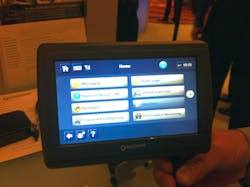Debunking myths holding back electronic logs
Seven myths—or, perhaps more accurately, misperceptions—that are holding back fleet owners from adopting electronic onboard recorders (EOBRs) to serve as “electronic logbooks” were laid out and duly exploded in a webinar hosted by Qualcomm Enterprise Services (QES), which is a provider of EOBR solutions.
Dave Kraft, director of industry affairs for QES, first detailed the EOBR mandate’s expected path-- as directed by the MAP-21 highway bill-- to a final rulemaking by the Federal Motor Carrier Safety Administration (FMCSA) out to when electronic logging will actually be implemented under the new regulation.
“The proposed EOBR rule will be out in mid-2013,” Kraft advised. “Although MAP-21 requires that a final rule be issued by Oct 1, 2013, realistically that rule will come in mid to late 2014. From there, the implementation period would not be within Map-21’s two-year window, but will extend out four to five years [from when the final rule is released].”
According to Kraft, the actual roll-out of EOBRs by fleets seeking to be in compliance with the new rule will be multi-faceted. “Implementation will involve EOBR product updates and certificates as well as carrier system upgrades and implementation of new [EOBR] systems.”
He pointed out that the mandate will ultimately have a huge impact on the industry. “Potentially [due to the rule], 3 million new EOBRs will be added to [the industry’s] current base of 500,000 to 600,000 units in use.”
As to why many fleet owners are hanging back from adopting EOBRs ahead of the mandate, Kraft revealed the seven myths he said are blinding buyers to the benefits electronic logging devices provide, mandate or not.
Myth #1: EOBRs infringe on driver privacy
Facts: “MAP-21 specifically limits use of EOBR data for inspections only. EOBR implementation has also demonstrated a strong track record for security and access controls, and history of GPS tracking use for log verification only,” stated Kraft
Panelist Vincent J. Dinino Jr., safety manager at Rochester, NY-based Emerson Express Co., pointed out that while there “originally was reluctance [from drivers], but the myth of EOBRs affecting their privacy was dispelled quickly once the system was implemented and drivers found it was user-friendly.”
Myth #2: Driver harassment (That EOBRs could force drivers to drive even when they’re too tired, etc.)
Facts: “FMCSA has been tasked with evaluating drivers and their ability to drive, and EOBRS have helped those drivers clearly define what their hours are,” contended Kraft..
Myth #3: Safety impact (That is, EOBRs don’t actually “solve” safety and compliance issues)
Facts: “CSA scores of fleets with EOBRs have improved, and the industry as a whole is getting fewer HOS violations (as EOBRS are becoming more widely used),” said Kraft. “ EOBRs, as part of a larger program, help build a culture of safety.”
“When drivers were on paper logs, they came home dog-tired,” remarkedPanelist Allen Lowry, director of safety for Central Refrigerated Service out of West City Valley, UT. “Drivers say now that EOBRs make them take breaks, they can actually function when they get home. Now we have a much more rested driver in the truck, because they’re required to take breaks. In addition to those safety benefits, and something we didn’t expect, was the improved attitude of the driver—there’s more trust now. EOBRs are also helpful with [defending] litigation issues,” he added.
Myth #4: EOBRs are very expensive
Facts: “Carriers that have implemented EOBRs have seen [acceptable] ROI,” said Kraft. “ Today, an EOBR is available for under $30 per month and [we expect] even more affordability as consumer devices [such as tablets and smartphones] become integrated with EOBRs.”
“We absolutely see a return on our investment,” stated Emerson’s Dinino. “We did a voluntary audit and we agreed that the ROI would be greater than the initial investment. We’ve also taken advantage of the DVIR books and electronic inspection books; those have helped our maintenance costs go down.”
Myth #5: Data manipulation (Data can easily be manipulated by drivers)
Facts: “Carriers are looking for log accuracy, and with EOBRs it’s very hard to make the data ‘go away,’” pointed out Kraft. “And enforcement is getting smarter. It’s getting increasingly harder to falsify this data. “
Myth #6: Enforcement
Facts: “State and local highway patrols are quickly getting trained on reading EOBRs, they’re staying up-to-date on inspections,” pointed out Kraft. “And drivers are now automatically where they need to be based on their HOS—making it easier for law enforcement to quickly move drivers through inspections—and resulting in fewer inspections and violations. “
“Our inspections and violations numbers have decreased [since implementing EOBRs,” said Dinino. “EOBRs have also made us more aware and [able to] concentrate on maintenance and a clean inspection.”
Myth #7: EOBRs are just ‘black boxes’
Fact: “EOBRs are really just information tools to help carriers and drivers manage compliance,” stated Kraft. “It’s a tool to manage a program.”
“EOBRs are incredibly valuable to the way we run our business,” noted Central’s Lowry. “One of the reasons we went to EOBRs was because of a DOT audit— [now] EOBRs make addressing audit issues easier.”
Kraft has authored a white paper, titled “Electronic Driver Logs Mandate and Hours of Service Compliance,”that touches on everything from carrier EOBR compliance to the value of implementing electronic logging devices.
